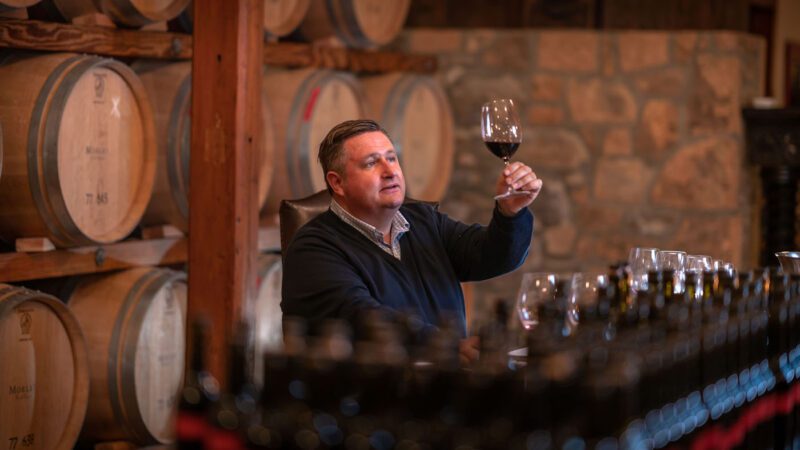Three vintners share what makes their bottles so special … and hard to get.
What do you get when you combine meticulously made, standout wines from some of Northern California’s most renowned grape-growing regions with availability that’s almost exclusively by mail and with yearslong waitlists? Cult favorites that oenophiles desperately want in their wine cellars. While these rare gems retail in the low hundreds from the wineries themselves, each goes for a considerably higher price on the secondary market.
Peter Michael Winery Point Rouge Estate
CHARDONNAY
Appellation: Knights Valley, Sonoma County
Cases produced annually: Less than 250
Waitlist: “Significant”
Winemaker Robert Fiore calls the Point Rouge Estate chardonnay a winemaker’s ultimate dream, allowing him “to go through the very best lots from each vineyard block and select the finest individual barrels to create a blend that represents that ultimate expression from that vintage.” The label is not vineyard-specific, so he sources fruit from three steep mountainous vineyards on volcanic soil, evaluates the best lots from each, and tastes barrel by barrel “in search of the sublime” before going through a multisession blending process. “The final blend of the selected barrels is not assembled until just before bottling to allow maximum sur lie aging,” he explains. “In the end, it’s the extraordinary terroir here at our Knights Valley estate that makes Point Rouge unique.” Each vintage flexes its own flavor profile with common waves of toasty brioche, bright honeysuckle, and citrus framed with an oystershell minerality; bottles will age gracefully for two to three decades.
Morlet Family Vineyards Force de la Nature
CABERNET FRANC
Appellation: Oakville, Napa Valley
Cases produced annually: Less than 250
Waitlist: 2+ years
While cabernet franc is traditionally used for blending, French-born Luc Morlet wanted to let the Bordeaux grape shine on its own. “The main idea is to capture a wine that is outside the ordinary, that has a strong personality,” the fifth-generation winemaker says. “It’s an intense and massive style but still very luscious, very soft tannins, and of course very complex.” This bottle’s name honors his great-grandfather: a large, spirited man and the force behind the family’s passion for winemaking. The first vintage was produced in 2010, and the 2015 got a future-altering 100-point rating from Robert Parker. While Morlet originally utilized grapes from Napa Valley’s well-regarded Beckstoffer To-Kalon vineyards, he and wife, Jodie, have since planted their own vineyards on 24 adjacent acres. Current vintages are now made exclusively from their estate-grown fruit and present an intense, full-bodied pairing of cracked pepper and mocha on the nose and palate swirled with notes of scorched earth and forest floor. The couple has dedicated a whopping one-third of the land to cabernet franc with “low vigor” rootstock, which means the vines bear less fruit but greater concentration. “As a wine grower,” Morlet says, “there’s much more satisfaction because we get the highest quality.”
MacDonald Winery
CABERNET SAUVIGNON
Appellation: Oakville, Napa Valley
Cases produced annually: 500
Waitlist: 6+ years
MacDonald Winery makes only one wine: a coveted cab that comes from some of the oldest vines in Napa Valley, originally planted by winemaker Graeme MacDonald’s great-grandparents 70 years ago at the acclaimed To-Kalon vineyard. For decades, the grapes were sold exclusively to family friend and legendary winemaker Robert Mondavi, who used them in his prestigious Reserve and To-Kalon bottles. In the aughts, the MacDonalds began experimenting with winemaking themselves; the 2010 vintage, released in 2013, was their first bottling. “It’s a real heritage thing,” says MacDonald, who personally handles the farming on the 15 acre block, while his brother Alex oversees the business side. “My connection to my earlier generations is being able to farm the vines that they planted. We only make what I can make with my own hands. Nobody else touches the wine.” The vineyard’s deep soil has a high gravel content that holds little water, making for an intense growing environment. “That means your vine puts its energy towards ripening and survival,” he says, “so you get a lot of power in the fruit.” The MacDonald cabernet is classically styled with notes of dark fruit, black olive, and pencil shavings and is balanced with fine tannins. “I make wine with restraint. You have to be willing not to extract everything from it, so it’s got plenty of minerality and concentration naturally.”
This article appeared in our September 2022 issue.
All images are courtesy of the respective winemakers.
